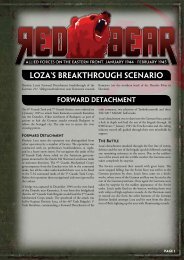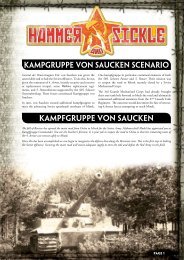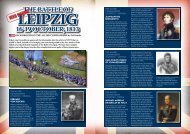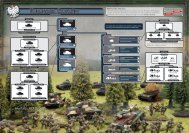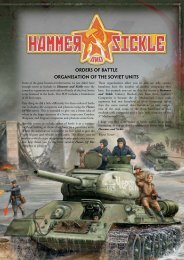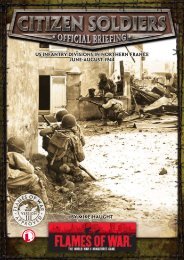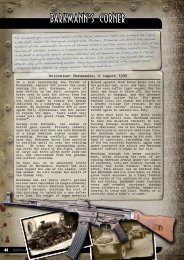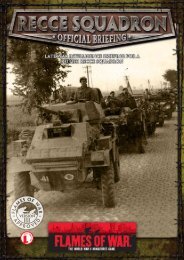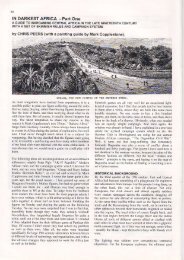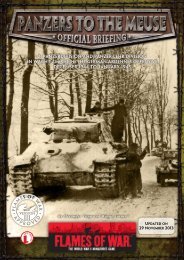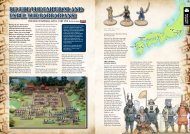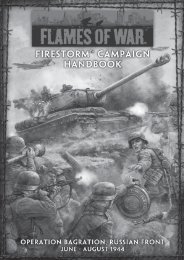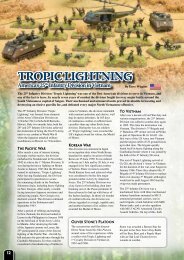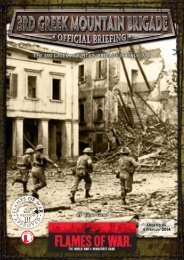INDIAN TRIBES OF THE EASTERN wOODLANDS ... - Flames of War
INDIAN TRIBES OF THE EASTERN wOODLANDS ... - Flames of War
INDIAN TRIBES OF THE EASTERN wOODLANDS ... - Flames of War
Create successful ePaper yourself
Turn your PDF publications into a flip-book with our unique Google optimized e-Paper software.
who relied on both tribes as allies. The<br />
Catawbas were ferocious warriors with<br />
a fearsome reputation. Early in the 18th<br />
century they helped South Carolina<br />
destroy the Tuscaroras, and drove the<br />
remnants north to become the Sixth<br />
Nation <strong>of</strong> the Iroquois. They also fought<br />
the Cherokees, Delawares and Shawnees<br />
- driving several bands <strong>of</strong> the latter<br />
from North Carolina into Pennsylvania.<br />
However constant warfare and disease<br />
steadily reduced their numbers as the<br />
18th century wore on.<br />
Already by the early 18th century the<br />
Catawbas had long been under British<br />
influence. While buckskin garments<br />
were still seen, most men wore muslin,<br />
calico or linen. Breechclouts and<br />
leggings were <strong>of</strong>ten made <strong>of</strong> red or<br />
blue wool strouding. Shirts might<br />
be decorated with complex patterns.<br />
Unlike their neighbours Catawba men<br />
wore their hair long, <strong>of</strong>ten pulled back<br />
into a ponytail style. The roach was<br />
apparently not worn, but some chiefs<br />
wore headdresses <strong>of</strong> upstanding turkey<br />
feathers. One <strong>of</strong> the most distinctive<br />
features <strong>of</strong> their appearance was<br />
the practice <strong>of</strong> cranial deformation,<br />
which led their enemies to call them<br />
“flatheads” - though this custom had<br />
probably died out by the mid 18th<br />
century. Moccasins were worn on the<br />
war trail, although the men <strong>of</strong>ten went<br />
barefoot at home. The Catawba had a<br />
very distinctive style <strong>of</strong> war paint: the<br />
lower face was black or red, with a<br />
white circle around one eye and a black<br />
circle around the other. Combined with<br />
their deformed skulls the effect must<br />
have been terrifying. Ignoring the<br />
“flat heads”, the Conquest Delaware<br />
figures with clothing painted as cloth<br />
instead <strong>of</strong> buckskin would make<br />
excellent Catawbas.<br />
CHEROKEE<br />
The Cherokee were the southernmost<br />
<strong>of</strong> the Iroquoian speaking tribes. Like<br />
their Iroquoian cousins they were very<br />
warlike, though they fared poorly<br />
against both the Catawbas and the<br />
Chickasaws. Conflict with their cousins<br />
<strong>of</strong> the Five Nations was common, with<br />
the Iroquois usually the aggressors.<br />
The Cherokees <strong>of</strong>ten responded to an<br />
Iroquois raid by sending one warrior<br />
north single-handed to collect a scalp.<br />
Cherokees and Shawnees also fought<br />
constantly, and the honours were about<br />
even. The formidable warriors <strong>of</strong> the<br />
Chickasaw, Catawba and Shawnee<br />
aside, the Cherokee more than held<br />
their own against other Indian enemies.<br />
They usually sided with the British,<br />
but early in the 19th century it became<br />
apparent that the Americans were now<br />
too powerful to be resisted, and they<br />
reluctantly agreed to be moved west.<br />
Skin breechclouts <strong>of</strong> the apron type were<br />
universal. Knee length leggings could<br />
also be worn, and in cooler weather a<br />
light skin poncho. From the middle <strong>of</strong><br />
the 18th century European style cloth<br />
shirts became available. Quillwork was<br />
rare, but some floral beadwork was done<br />
on pouches and shoulder bags, with<br />
circular motifs being the most popular.<br />
Men shaved their heads except for a<br />
roach running from front to back on<br />
top <strong>of</strong> the head, <strong>of</strong>ten with a fringe <strong>of</strong><br />
hair along the forehead. The roach was<br />
frequently augmented by opossum or<br />
deer hair dyed red or yellow. Symbols<br />
such as flowers, animals and stars were<br />
tattooed on the arms, torso, and thighs.<br />
<strong>War</strong>riors used red paint to signify<br />
success, blue for trouble or defeat,<br />
black for death, and white for peace and<br />
happiness. Red and black were therefore<br />
the most popular war colours.



